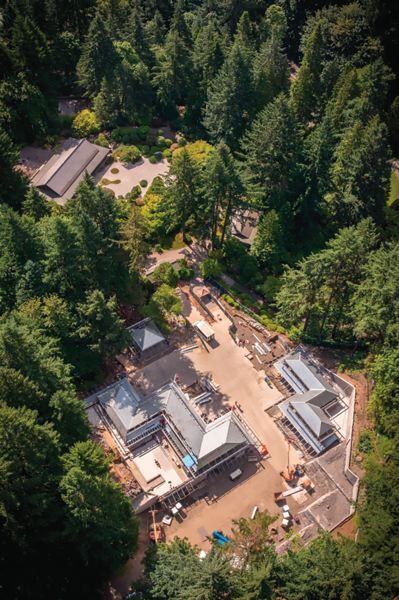Portland Japanese Garden’s new floating world
Published 12:00 am Thursday, March 30, 2017

- An aerial view of the site under construction last fall shows the buildings separated by a plaza, under which is an active landslide moving at about an eighth of an inch per year.
If you thought this winter was harsh, it’s been tougher at the Portland Japanese Garden.
Trending
Perched 500 feet above downtown in the snow- and mudslide-prone West Hills, construction crews have raced against the clock to finish a series of new buildings in time for cherry blossom season.
Balazs Bognar is Chief Manager at Kengo Kuma & Associates, the world-class Japanese architect brought in to design the $31.5 million Portland Japanese Garden Expansion, which opens Sunday, April 2. Based in Tokyo, Bognar has visited the garden 37 times since the project was greenlighted.
“The unpredictable weather was a challenge,” he told the Business Tribune on Tuesday. “My January trips were particularly odd because I’d make it here from Japan and the construction site would be quieted down, blanketed in snow, with nobody allowed up here for safety reasons.”
Trending
Making up those lost days put pressure on the crew, but he said the team of Kuma, Hoffman Construction and Hacker (the architect of record) had to up the ante as far as coordination was concerned. “It seems as if nobody skipped a beat.”
Cheery Bloom
There is some construction remaining, and some fundraising. Garden CEO Stephen Bloom estimates they are 95 percent through both, and will be finished by the summer.
The Portland Japanese Garden Expansion project was built to remove certain functions that were cluttering the park and compromising its peace and quiet, and group them in an expanded “cultural village.”
The work required building on a slope in a wooded area and with only a small access road. The Japanese Garden closed to the public for six months through March 2017 while the bulk of the machinery and materials were brought in with limited street access and turning space.
Visitors now get their tickets at street level and ascend a trail. The first thing they see on the left is the new teahouse, which has narrow steel stilts and huge windows. It is designed to look as though it is floating. Kuma’s concept is that it is “not a building, but a roof to cover the ground.”
No coffee zone
“The cafe (which does not serve coffee, only tea) has the most substantial engineering work, and no one will ever see it,” confided Bognar. The black two-by-four steel supports are oriented so you see their thin edge when you are looking at the city view.
The seemingly delicate structure is held up by a wall that backs up the cafe’s service area. This is a substantial vertical concrete cantilever that goes all the way down to the bedrock.
Bognar said that Kuma came at the project from an aesthetic point of view, then the engineers would try to make his vision happen.
The notorious “active landslide” down the center of the site, in which one side moves downhill at around an eighth of an inch per year faster than the other, was not really a big deal. Engineers said it would be fine as long as they didn’t build on it, so it now runs underneath the paved plaza.
Floating
The true goal of Kuma’s architecture is “to take away the burden from the visitors’ experience, so they are not looking at a lot of structure, they’re looking at the scene and the view,” says Bognar.
“We try to detail things lightly and delicately so the architecture is not the heavy presence. It’s more about what we are framing, the view of the gardens beyond.”
Hence lots of clean lines, bevels and thin edges. Door handles are hard to find and drainpipes are missing. Rain drips from the exaggerated eaves into gravel-filled trenches. The goal is to let humans and nature access each other.
The project has taken 19 months. General contractor Hoffman claims the work demanded as high a level of precision as their work for the glass Seattle Public Library designed by Rem Koolhaas.
Actually, doors are hard to find. The corners of some buildings open right up so there is no feeling of a gateway or defined entrance.
“When you have gardens as beautiful as this it’s quite easy to do clean architectural moves. The human experience is defined by our relation to nature, and architecture is our way to do that, it’s something in between humans and nature.”
Room to spare
The problem at the Portland Japanese Garden was always lack of space as attendance grew. In its opening year, 1967, it had 28,500 visitors. In 2016, 356,000. Recent growth has been rapid as Portland has become an international tourist destination. Attendance has increased between 10-20 percent every year for the last five years. By comparison, between 600,000 and 650,000 visitors a year visit the free International Rose Test Garden nearby.
This new Cultural Village extends the educational programming of the garden, which are essential to the tax breaks it gets as a nonprofit.
Garden CEO Bloom said almost all of the money was privately raised, except for $500,000 from the National Endowment for the Humanities and $1.5 million from the Oregon Lottery.
So the business has no new debt, but as it moves from a $4.4 million a year operating budget to $9.5 million this year, almost doubling its workforce to 90 full-time employees, it needs new revenue. Sixty percent currently comes from admissions. The adult ticket price is going up from $9.50 to $14.95.
Shopping
Retail is a small portion of what they do, but Bloom is proud of the fact that the old gift shop, at 167 square feet, did $1.1 million annually in gross sales. The new gift shop, which has silk scarves for $200 and tiny notepads for $15, as well as budget items such as magnets and chopstick holders, is four times bigger. “We are conservative and estimate it will bring in 50 percent more in sales.”
The main bump in revenue should come from admissions. “We project between 500,000 and 600,000 visitors in 2017, up from last year’s just under 400,000. We expect a bubble because of the new buildings and that will roll back after the first year.”
Garden management estimates the project will put $94 million back into the Oregon economy.
There should be income from teaching. The new Garden House for horticulture workshops should attract gardeners from North America’s 250 Japanese Gardens who don’t want to travel to Japan and study with a sensei for six years, as is often the case.
The center seems ready to surf the silver tsunami of ageing boomers with cash to spend. The largest building is the Jordan Schnitzer Japanese Arts Learning Center which will house gallery shows and other lessons in Japanese culture to paying customers, from flower arranging to calligraphy.






